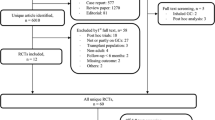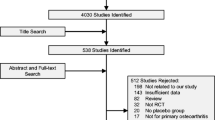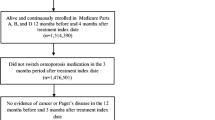Abstract
Objective: To develop a method that estimates and compares the antifracture efficacy [relative risk reduction (RRR) and number needed to treat (NNT)] of various antiresorptive agents when fracture trials are not available.
Design, Setting and Patients: Statistical analysis using efficacy data from clinical trials of postmenopausal women with osteoporosis.
Interventions: Oral alendronate 5mg, oral alfacalcidol lμg, or intranasal calcitonin 200IU daily.
Methods: We used the effects on bone mineral density (BMD) in head-to-head trials together with the relationship between BMD changes and fracture risk reductions reported in published meta-analyses of antifracture trials to predict and compare RRR and NNT.
Results: The predicted RRR was similar to the published values in large clinical trials, thus validating the method. With an incidence of 12% over 3 years in untreated women with pre-existing vertebral fractures (based on a large epidemiological study), the predicted NNT to prevent a new vertebral fracture was 17 for alendronate and 29 for alfacalcidol; similar results were observed for alendronate versus calcitonin. For nonvertebral fractures, the NNT was three to four times lower for alendronate, compared with alfacalcidol and calcitonin.
Conclusions: There is currently insufficient evidence of antifracture efficacy from randomised trials to recommend the use of alfacalcidol or calcitonin for treating osteoporosis. Furthermore, our analyses indicate that alendronate is substantially more effective for reducing vertebral and nonvertebral fracture risk than alfacalcidol or calcitonin.




Similar content being viewed by others
References
Kanis JA, Delmas P, Burckhardt P, et al. Guidelines for diagnosis and management of osteoporosis. Osteoporos Int 1997; 7: 390–406
Johnell O. The socioeconomic burden of fractures: today and in the 21st century. Am J Med 1997; 103: 20S–6S.
Garnero P, Sornay-Rendu E, Chapuy M-C, et al. Increased bone turnover in late postmenopausal women is a major determinant of osteoporosis. J Bone Miner Res 1996; 11: 337–49
Guyatt GH. Evidence-based management of patients with osteoporosis. J Clin Densitom 1998; 1: 395–402
Cummings SR, Chapurlat RD. What PROOF proves about calcitonin and clinical trials. Am J Med 2000; 109: 330–1
Wasnich RD, Miller PD. Antifracture efficacy of antiresorptive agents are related to changes in bone density. J Clin Endocrinol Metab 2000; 85: 231–6
Hochberg MC. Preventing fractures in postmenopausal women with osteoporosis: a review of recent controlled trials of antiresorptive agents. Drugs & Aging 2000; 17(4): 317–30
Black DM, Reiss TF, Nevitt MC, et al. Design of the Fracture Intervention Trial. Osteoporos Int 1993; 3: S29–39
Shiraki M, Kushida K, Fukunaga M, et al. A double-masked multicenter comparative study between alendronate and alfacalcidol in Japanese patients with osteoporosis. Osteoporos Int 1999; 10: 183–92
Downs RW Jr, Bell NH, Ettinger MP, et al. Comparison of alendronate and intranasal calcitonin for treatment of osteoporosis in postmenopausal women. J Clin Endocrinol Metab 2000; 85: 1783–8
Adami S, Passeri M, Ortolani S, et al. Effects of oral alendronate and intranasal salmon calcitonin on bone mass and biochemical markers of bone turnover in postmenopausal women with osteoporosis. Bone 1995; 17(4): 383–90
Miller PD, Hochberg MC, Greenspan S, et al. Increases in bone mineral density explain the reduction in incidence of non-vertebral fractures seen with antiresorptive therapy in women with postmenopausal osteoporosis. J Clin Densitom. In press
Black DM, Pearson J, Harris F, et al. Predicting the effect of antiresorptive treatments on risk of vertebral fractures: a meta-analysis [abstract]. J Bone Miner Res 1999; 14Suppl. 1: S137
Laupacis A, Sackett DL, Roberts RS. An assessment of clinically useful measures of the consequences of treatment. N Engl J Med 1988; 318: 1728–33
Chatellier G, Zapletal E, Lemaitre D, et al. The number needed to treat: a clinically useful nomogram in its proper context. BMJ 1996; 312: 426–9
Cook RJ, Sackett DL. The number needed to treat: a clinically useful measure of treatment effect. BMJ 1995; 310: 452–4
Liberman UA, Weiss SR, Broil J, et al. Effect of oral alendronate on bone mineral density and the incidence of fractures in postmenopausal osteoporosis. N Engl J Med 1995; 333: 1437–43
Black DM, Cummings SR, Karpf DB, et al. Randomised trial of effect of alendronate on risk of fracture in women with existing vertebral fractures. Lancet 1996; 348: 1535–41
Black DM, Arden NK, Palermo L, et al. Prevalent vertebral deformities predict hip fractures and new vertebral deformities but not wrist fractures. J Bone Miner Res 1999; 14: 821–8
Cummings SR, Black DM, Thompson DE, et al. Effect of alendronate on risk of fracture in women with low bone density but without vertebral fractures: results from the Fracture Intervention Trial. JAMA 1998; 280: 2077–82
Black DM, Thompson DE, Bauer D, et al. Fracture risk reduction with alendronate in women with osteoporosis: The Fracture Intervention Trial. J Clin Endocrinol Metab 2000; 85(11): 4118–24
Meunier PJ. Evidence-based medicine and osteoporosis: a comparison of fracture risk reduction data from osteoporosis randomised clinical trials. Int J Clin Pract 1999; 53: 122–9
Orimo H, Shiraki M, Hayashi Y, et al. Effects of 1 alpha-hydroxyvitamin D3 on lumbar bone mineral density and vertebral fractures in patients with postmenopausal osteoporosis. Calcif Tissue Int 1994; 54: 370–6
Windeier J, Lange S. Events per person year —a dubious concept. BMJ 1995; 310: 454–6
Shiraki M, Kushida K, Yamazaki K, et al. Effects of 2 years’ treatment of osteoporosis with 1 alpha-hydroxy vitamin D3 on bone mineral density and incidence of fracture: a placebo-controlled, double-blind prospective study. Endocr J 1996; 43: 211–20
Chesnut CH, Silverman S, Andriano K, et al. Arandomized trial of nasal spray salmon calcitonin in postmenopausal women with established osteoporosis: the Prevent Recurrence of Osteoporotic Fractures study. Am J Med 2000; 109: 267–76
Tonino RP, Meunier PJ, Emkey R, et al. Skeletal benefits of alendronate: 7-year treatment of postmenopausal osteoporotic women. J Clin Endocrinol Metab 2000; 85(9): 3109–15
Lips P, Graafmans WC, Ooms ME, et al. Vitamin D supplementation and fracture incidence in elderly persons. A randomized, placebo-controlled clinical trial. Ann Intern Med 1996; 124: 400–6
Acknowledgements
The authors thank Dr Philip Ross, Merck & Co., Inc., for assistance with the analysis and preparation of the manuscript.
Author information
Authors and Affiliations
Corresponding author
Rights and permissions
About this article
Cite this article
Aoyagi, K., Shiraki, M., Ito, M. et al. Statistical Analysis for Comparing Antifracture Efficacy among Antiresorptive Agents. Clin. Drug Investig. 21, 415–422 (2001). https://doi.org/10.2165/00044011-200121060-00004
Published:
Issue Date:
DOI: https://doi.org/10.2165/00044011-200121060-00004




